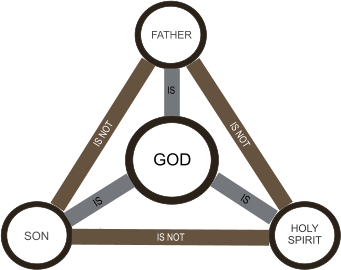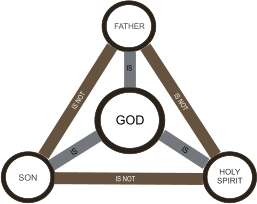
Three
In
human
experience,
as
well
as
the
Bible,
certain
numbers,
or
their
multiples,
symbolize
qualities
beyond
the
quantity
that
they
designate.
For
instance,
1,
2,
3,
4,
7,
and
12
have
in
common
the
idea
of
completeness
,
though
different
nuances
of
it.
Nothing
represents
the
completeness
of
unity
better
than
one
.
Two
suggests
the
completeness
of
compatibility
,
as
in
the
marriage
of
a
man
and
woman
acting
as
one.
Four
symbolizes
the
completeness
of
wholeness
,
as
in
“the
whole,
wide
world,”
whose
parts
interact
as
a
single
operating
system.
Thus,
the
four
winds
refer
to
one
world,
the
four
corners
to
one
earth,
and
the
four
compass
points
—
north,
south,
east,
and
west
—
to
one
globe.
Seven
is
emblematic
of
the
completeness
of
perfection
,
perhaps
because
it
is
the
sum
of
the
three
of
divinity
and
the
four
of
the
world.
So,
seven
days
comprise
a
full
week
and
“the
seven
seas”
all
the
oceans.
Twelve
represents
the
completeness
of
plenitude
,
as
recognized
in
Scripture
by
the
twelve
tribes
of
Israel
and
the
twelve
apostles
(cf.
Matt.
19:28)
and
in
daily
life by a special name:
dozen
, as in eggs or doughnuts.
Three
suggests
the
completeness
of
sufficiency
.
“With
‘3’
we
are
dealing
with
the
chief
mystic
number
of
all
time.
The
figure
‘3’
gains
its
importance
because
it
is
made
up
of
‘1+1+1.’
It
is
evenly
balanced
with
a
beginning,
a
middle
and
an
end,
that
is
birth,
living,
dying
…,
but
the
magic
of
‘3’
…
can
be
said
to
represent
the
oldest
trinity
known
to
man
–
father,
mother,
child.
Then
we
have
the
‘threes’
of
earth,
sea,
and
sky;
and
sun,
moon,
and
stars.
Everywhere
and
always
‘3’
has
contained
the
idea
of
‘all’
or
‘completeness.’
…
Also
note
in
our
common
speech
the
‘allness’
and
finality
of
‘3
strikes
and
out,’
‘1,2,3,
go,’
‘I’ll
give
you
three
chances,’
and
the
superstitions
…
about
the
accidents
that
come
in
‘3’s”
(Wilfred
Funk,
Word
Origins
,
pp. 323-4).
In
the
Bible,
there
is
the
sufficiency
of
prayer
,
as
when
Jesus
prayed
three
times
in
Gethsemane
(Matt.
26:36-46).
There
is
the
sufficiency
of
effort
,
as
when
Christ
prescribed
three
approaches
to
an
errant
brother
(Matt.
18:15-17).
There
is
the
sufficiency
of
judgment
,
as
when
the
Law
of
Moses
required
two
or
three
witnesses
for
capital
crimes
(Deut. 17:6).
The
Trinity
is
the
most
prominent
three
and
the
most
difficult.
(Trinity
means
“three
in
one,”
from
Latin
“tres”
and
“unus,”
“three”
and
“one”).
None
has
trouble
seeing
a
married
man
and
woman
as
one
pair,
the
four
corners
of
the
earth
as
one
world,
“the
seven
seas”
as
one
ocean,
and
Israel’s
twelve
tribes
as
one
nation,
they
have
difficulty
seeing
how
the
divine
three
—
the
Father,
the
Son,
and
the
Holy
Spirit
—
can
be
one.
Yet,
the
Bible
teaches
from
its
beginning
that
God
is
a
plurality
acting
as
one
.
A
secular
example
of
this
is
a
traditional
Russian
troika.
When
God
created
the
first
humans,
He
said,
“Let
Us
make
man
in
Our
image
…”
(Gen.
1:26).
Some
insist
that
God
is
an
absolute
one,
despite
the
obvious
significance
of
the
plural
pronoun,
“us,”
by
claiming
that
this
is
a
“plural
of
majesty,”
like
a
“royal
we.”
Yet,
even
a
“royal
we”
still
includes
an
actual
plurality. Many subjects speak in their one king.
The
next
time
the
plural
is
used
to
refer
to
God,
He
says,
“Behold,
the
man
has
become
like
one
of
Us
…”
(Gen.
3:22).
“One
of
Us”
clearly
shows
that
the
members
of
this
divine
plurality
are
distinguishable
from
each
other,
in
such
a
way
that
would
not
be
possible
if
God
were
not
a
plurality.
The
God
of
the
Bible
is
still
monotheistic
as
a
compound
one
—
actually
three
but
effectively
one
(Deut.
6:4).
He
is
the
perfectly
unified
threesome.
Inability
to
comprehend
how
God
can
be
three
but
one
is
no
excuse
for
the
rejection
of
plain
Bible
teaching.
Apprehension
of
truth
must
be
limited
only
by
divine revelation
, not by
human understanding
.
“And if one can overpower him who is alone, two can resist him. A cord of three strands is not
quickly torn apart” (Ecclesiastes 4:12).







“And if one can overpower him who is alone, two can resist him.
A cord of three strands is not quickly torn apart” (Ecclesiastes 4:12).

Three
In
human
experience,
as
well
as
the
Bible,
certain
numbers,
or
their
multiples,
symbolize
qualities
beyond
the
quantity
that
they
designate.
For
instance,
1,
2,
3,
4,
7,
and
12
have
in
common
the
idea
of
completeness
,
though
different
nuances
of
it.
Nothing
represents
the
completeness
of
unity
better
than
one
.
Two
suggests
the
completeness
of
compatibility
,
as
in
the
marriage
of
a
man
and
woman
acting
as
one.
Four
symbolizes
the
completeness
of
wholeness
,
as
in
“the
whole,
wide
world,”
whose
parts
interact
as
a
single
operating
system.
Thus,
the
four
winds
refer
to
one
world,
the
four
corners
to
one
earth,
and
the
four
compass
points
—
north,
south,
east,
and
west
—
to
one
globe.
Seven
is
emblematic
of
the
completeness
of
perfection
,
perhaps
because
it
is
the
sum
of
the
three
of
divinity
and
the
four
of
the
world.
So,
seven
days
comprise
a
full
week
and
“the
seven
seas”
all
the
oceans.
Twelve
represents
the
completeness
of
plenitude
,
as
recognized
in
Scripture
by
the
twelve
tribes
of
Israel
and
the
twelve
apostles
(cf.
Matt.
19:28)
and
in
daily
life
by
a
special
name:
dozen
,
as
in
eggs
or
doughnuts.
Three
suggests
the
completeness
of
sufficiency
.
“With
‘3’
we
are
dealing
with
the
chief
mystic
number
of
all
time.
The
figure
‘3’
gains
its
importance
because
it
is
made
up
of
‘1+1+1.’
It
is
evenly
balanced
with
a
beginning,
a
middle
and
an
end,
that
is
birth,
living,
dying
…,
but
the
magic
of
‘3’
…
can
be
said
to
represent
the
oldest
trinity
known
to
man
–
father,
mother,
child.
Then
we
have
the
‘threes’
of
earth,
sea,
and
sky;
and
sun,
moon,
and
stars.
Everywhere
and
always
‘3’
has
contained
the
idea
of
‘all’
or
‘completeness.’
…
Also
note
in
our
common
speech
the
‘allness’
and
finality
of
‘3
strikes
and
out,’
‘1,2,3,
go,’
‘I’ll
give
you
three
chances,’
and
the
superstitions
…
about
the
accidents
that
come
in
‘3’s”
(Wilfred
Funk,
Word
Origins
, pp. 323-4).
In
the
Bible,
there
is
the
sufficiency
of
prayer
,
as
when
Jesus
prayed
three
times
in
Gethsemane
(Matt.
26:36-46).
There
is
the
sufficiency
of
effort
,
as
when
Christ
prescribed
three
approaches
to
an
errant
brother
(Matt.
18:15-17).
There
is
the
sufficiency
of
judgment
,
as
when
the
Law
of
Moses
required
two
or
three
witnesses for capital crimes (Deut. 17:6).
The
Trinity
is
the
most
prominent
three
and
the
most
difficult.
(Trinity
means
“three
in
one,”
from
Latin
“tres”
and
“unus,”
“three”
and
“one”).
None
has
trouble
seeing
a
married
man
and
woman
as
one
pair,
the
four
corners
of
the
earth
as
one
world,
“the
seven
seas”
as
one
ocean,
and
Israel’s
twelve
tribes
as
one
nation,
they
have
difficulty
seeing
how
the
divine
three
—
the
Father,
the
Son,
and
the
Holy
Spirit
—
can
be
one.
Yet,
the
Bible
teaches
from
its
beginning
that
God
is
a
plurality
acting
as
one
.
A
secular
example
of
this
is
a
traditional
Russian
troika.
When
God
created
the
first
humans,
He
said,
“Let
Us
make
man
in
Our
image
…”
(Gen.
1:26).
Some
insist
that
God
is
an
absolute
one,
despite
the
obvious
significance
of
the
plural
pronoun,
“us,”
by
claiming
that
this
is
a
“plural
of
majesty,”
like
a
“royal
we.”
Yet,
even
a
“royal
we”
still
includes
an
actual
plurality.
Many
subjects
speak
in
their
one
king.
The
next
time
the
plural
is
used
to
refer
to
God,
He
says,
“Behold,
the
man
has
become
like
one
of
Us
…”
(Gen.
3:22).
“One
of
Us”
clearly
shows
that
the
members
of
this
divine
plurality
are
distinguishable
from
each
other,
in
such
a
way
that
would
not
be
possible
if
God
were
not
a
plurality.
The
God
of
the
Bible
is
still
monotheistic
as
a
compound
one
—
actually
three
but
effectively
one
(Deut.
6:4).
He
is
the
perfectly
unified
threesome.
Inability
to
comprehend
how
God
can
be
three
but
one
is
no
excuse
for
the
rejection
of
plain
Bible
teaching.
Apprehension
of
truth
must
be
limited
only
by
divine revelation
, not by
human understanding
.






